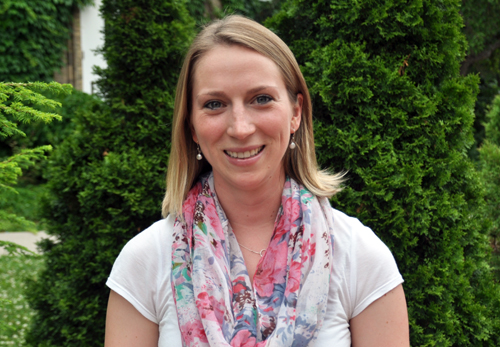
Osteoarthritis affects millions of people, but despite its prevalence — especially among seniors — few treatment options are available and there is no cure.
A University of Guelph graduate student is hoping to help alleviate pain and suffering in those afflicted.
Erin Connelly, a PhD student in the Department of Human Health and Nutritional Science (HHNS), is studying the effects of lifestyle factors in people with osteoarthritis of the knee.
“I’m looking at medication and supplement use, alternative therapies, diet and exercise as contributors to pain and other osteoarthritis symptoms in this study.”
Osteoarthritis is a chronic condition that involves the breakdown of cartilage in the joints, Connelly explains.
“Cartilage is the substance that lines the ends of your bones. It helps absorb forces when you walk or move and helps the joint move smoothly,” she says.
As cartilage deteriorates, pain, stiffness and joint damage can occur, and the space between the bones shrinks. Eventually, the bones begin to rub against each other.
“There’s no effective treatment,” Connelly says. Currently, the best option is replacing the joint, which involves expensive, major surgery. The wait time for joint replacement surgery in Canada can be up to two years. To be eligible for surgery, candidates need to have experienced significant cartilage deterioration.
“People just manage their symptoms with pain medications that can predispose them to adverse effects — gastrointestinal and cardiac,” she says.
Exercise often helps alleviate joint pain, she says. But for some people, activities such as running can worsen pain, and any joint injuries that occur can make people more susceptible to developing osteoarthritis.
But a lack of physical activity is also a risk factor for developing osteoarthritis. Not moving contributes to joint pain and other health problems. Up to 80 per cent of people who have osteoarthritis also have another chronic condition, she says.
So how much and how often should people exercise?
“We’re not 100-per-cent sure,” Connelly says of the effects of exercise. “It makes it really difficult to give people information about how to handle it.”
Osteoarthritis is an age-related condition, she adds, but the risk is higher among women and people who are obese. It’s also the most common cause of disability in North America.
Some studies have shown a dietary link to osteoarthritis, such as being deficient in certain vitamins or minerals, but clinical trials with supplements have not shown any benefits for people with osteoarthritis, Connelly says. Research on joint supplements such as glucosamine and MSM (methylsulfonylmethane) remains inconclusive.
“Instead of looking at individual vitamins, we want to look at a healthy eating pattern, such as fruit and vegetable intake,” she says.
She is currently looking for participants with knee osteoarthritis to complete a survey about their health history, diet and exercise. If you’re interested in participating, contact her at adele@uoguelph.ca.
“You’re living with a lot of pain; you’re living with a lot of disability,” Connelly says. “If we can help people to have less pain and more movement, their quality of life is going to improve.”
The lack of treatment options for a disease that affects millions of people inspired her to learn more about osteoarthritis in the hope of helping others. During her master’s research at U of G, she noticed that people with osteoarthritis were trying various treatments, such as acupuncture, nerve stimulation and physiotherapy, and she wanted to learn how these treatments affected their pain.
She recommends gentle exercise combined with occasional pain medication or supplements based on advice from a health-care provider. Managing osteoarthritis depends on the individual, she adds, and some people respond well to certain types of treatment while others don’t.
Connelly also worked on a clinical trial that looked at the effects of drinking mint tea, which helped reduce pain and improve physical function in all participants.
Of the 60 people who participated in the study, half were given regular mint tea twice a day while the other half were given mint tea that contained higher amounts of a naturally-occurring anti-inflammatory compound called rosmarinic acid. Both groups experienced a reduction in pain, but only the group that drank the enhanced mint tea experienced a significant improvement. The study has been accepted for publication later this year by the Journal of Medicinal Foods.
The mint used in the study was developed by Prof. Laima Kott in the Department of Plant Agriculture.
Connelly’s research is supervised by Profs. Amanda Wright and Alison Duncan, HHNS.